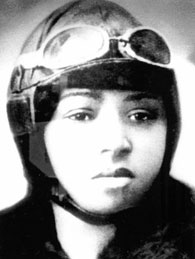Bio

After moving to Chicago around the time of World War I, Coleman became interested in the air war in Europe. She decided to become a pilot but could find no flight school to accept her. With the financial assistance and advice of the editor of the Chicago Weekly Defender, she enrolled in an aviation school in France. In 1921, she earned a pilot's license from the Federation Aeronautique Internationale.
She performed widely across the U.S. Her first Texas appearance was on June 19, 1925, in Houston. She encouraged young blacks to become involved in aviation. She once refused to perform in Waxahachie, where she had grown up, until blacks were allowed to use the same entrance as whites to the exhibition.
In 1926, Coleman died during a test flight in Florida. Black aviators memorialized her by naming their flying clubs and their magazine after her. In 1990, a street to Chicago's O'Hare Airport was named Bessie Coleman Drive, and, in 1995, the U.S. Postal Service issued a commemorative stamp in her honor.
Audio
Written by Cynthia J. Beeman
Read by Angela Shelf Medearis
When Bessie Coleman wanted to become a pilot, no flying school would admit her because she was black and a woman. Undeterred, Coleman—who was born in Atlanta, Texas, and grew up in poor sharecropper family in Waxahachie—obtained a sponsor and went to France for training. In 1921, she became the first black woman in the world to earn a pilot’s license. She returned to the U.S. and flew in a series of airshows, performing stunts as a barnstorming pilot whenever she could borrow an airplane. Her dream was to earn enough money to buy her own plane and "to make Uncle Tom’s cabin into a hangar by establishing a flying school" for African Americans. Delighting audiences across the country with her acrobatic flying, she became known as "Queen Bess." At an airshow in Waxahachie, she refused to fly when she found out black patrons were expected to enter the fairgrounds through a separate gate from the white audience. Since she was the prime attraction, the event’s promoters gave in to her demands and the show went on.
In April 1926, as Coleman was preparing to fly in an airshow in Jacksonville, Florida, she fell to her death from the plane’s open cockpit. Only 34 years old at the time, she was celebrated as a trailblazer for African Americans and women, and her story continues to inspire young people of all races.
Resources
Utley, Dan K. and Cynthia J. Beeman. History Ahead: Stories beyond the Texas Roadside Markers (College Station: Texas A&M University Press, 2010).
Bessie Coleman historical marker files (Cass and Ellis counties), Texas Historical Commission, Austin.
Biography Source Information
Biographies are reprinted from the Foundation for Women’s Resources (now Women’s Resources), Dallas, Texas. They originally appeared in "From Gutsy Mavericks to Quiet Heroes: True Tales of Texas Women," video study guide, Austin: The Foundation for Women's Resources, 1997. Death dates have been added where needed.
Audio Source Information
Our project, "Texas Women's History Moments," received the 2012 National Council on Public History Outstanding Public History Award and the American Association for State and Local History Leadership in History Award. The audio clips were broadcast on KUT radio from 2011-2016 during Women’s History Month.